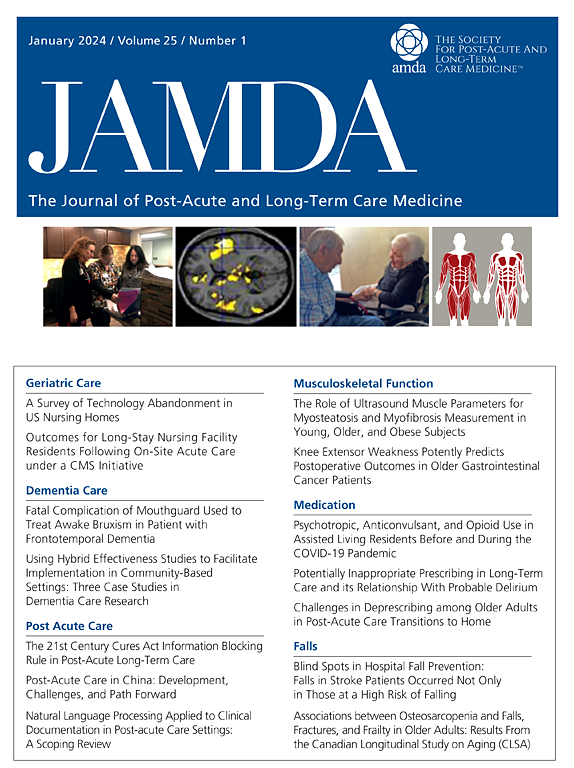镁摄入量越高,老年人体弱的风险越低。
IF 4.2
2区 医学
Q2 GERIATRICS & GERONTOLOGY
Journal of the American Medical Directors Association
Pub Date : 2024-11-02
DOI:10.1016/j.jamda.2024.105335
引用次数: 0
摘要
目的:镁缺乏症在老年人中很常见,与肌肉功能减退和多种老年相关疾病有关。有关镁与虚弱关系的证据却很少。我们的目的是在 Seniors-ENRICA-1 队列中探讨镁摄入量与体弱事件的关系:设计:前瞻性纵向队列研究:ENRICA研究是一项基于人口的研究(N = 13,105),包括西班牙18岁及以上非住院人口的代表性样本。在本次分析中,我们使用了基线年龄在 60 岁及以上的社区居民参与者的数据(n = 2519)。在排除其他数据后,我们纳入了 1900 名老年人-ENRICA-1 队列参与者(平均年龄为 68.7 ± 6.4 岁;51.7% 为女性)的数据:在基线时,我们使用经过验证的、基于计算机的面对面膳食史(DH-ENRICA)对食物摄入量进行了评估,并从中估算出镁摄入量。在弗里德标准(疲惫、体力活动少、步态缓慢、虚弱和体重减轻)中,有 3 项或 3 项以上的标准即为体弱。分析采用逻辑回归法,并对潜在的混杂因素进行了调整:在平均 3.5 年的随访期间,新增了 136 例虚弱病例(7.2%)。与镁摄入量最低的性别特异性四分位数相比,在镁摄入量不断增加的四分位数中,发生虚弱的完全调整几率比(95% CI)分别为 0.62(0.36,1.07)、0.53(0.28,0.98)和 0.43(0.21,0.86)(P-趋势 = .016)。慢步速度的相应结果分别为 0.68(0.47,1.01)、0.58(0.37,0.89)和 0.52(0.32-0.84)(P-趋势 = .008)。其他弗里德标准也显示出类似的趋势,即随着镁摄入量的增加,虚弱发生率会降低,但在完全调整模型中未达到统计学意义:在社区居住的老年人中,较高的镁摄入量与较低的虚弱风险(尤其是步速缓慢)呈独立的反比关系,这表明摄入充足的这种重要离子有助于预防不健康的衰老。本文章由计算机程序翻译,如有差异,请以英文原文为准。
Higher Magnesium Intake Is Associated with a Lower Risk of Frailty in Older Adults
Objectives
Magnesium deficiency is common in older adults and has been associated with reduced muscle functionality and several age-related diseases. Evidence of its relationship with frailty is scarce. We aimed to explore the association of magnesium intake with incident frailty in the Seniors-ENRICA-1 cohort.
Design
Prospective longitudinal cohort study.
Setting and Participants
The ENRICA study is a population-based study (N = 13,105) that includes a representative sample of the noninstitutionalized Spanish population aged 18 years and older. For the present analyses, we used data from the community-dwelling participants aged 60 years and older at baseline (n = 2519). After exclusions, we included data from 1900 participants of the Seniors-ENRICA-1 cohort (mean age 68.7 ± 6.4 years; 51.7% women).
Methods
Food consumption was assessed at baseline with a validated, computer-based, face-to-face dietary history (DH-ENRICA), from which magnesium intake was estimated. Frailty was defined as having 3 or more of Fried criteria: exhaustion, low physical activity, slow gait speed, weakness, and weight loss. Analyses were performed with logistic regression adjusted for potential confounders.
Results
During a mean follow-up of 3.5 years, 136 new cases (7.2%) of frailty occurred. Compared with the lowest sex-specific quartile of magnesium intake, the fully adjusted odds ratio (95% CI) for incident frailty across increasing quartiles of intake was 0.62 (0.36, 1.07), 0.53 (0.28, 0.98), and 0.43 (0.21, 0.86), respectively (P-trend = .016). Corresponding results for slow gait speed were 0.68 (0.47, 1.01), 0.58 (0.37, 0.89), and 0.52 (0.32-0.84), respectively (P-trend = .008). Other Fried criteria showed a similar tendency to reduced frailty incidence with increasing magnesium intake, without achieving statistical significance in the fully adjusted model.
Conclusions and Implications
Higher magnesium intake was inversely and independently associated with lower frailty risk, especially of slow gait speed, in community-dwelling older adults, suggesting that adequate intake of this vital ion could help prevent unhealthy aging.
求助全文
通过发布文献求助,成功后即可免费获取论文全文。
去求助
来源期刊
CiteScore
11.10
自引率
6.60%
发文量
472
审稿时长
44 days
期刊介绍:
JAMDA, the official journal of AMDA - The Society for Post-Acute and Long-Term Care Medicine, is a leading peer-reviewed publication that offers practical information and research geared towards healthcare professionals in the post-acute and long-term care fields. It is also a valuable resource for policy-makers, organizational leaders, educators, and advocates.
The journal provides essential information for various healthcare professionals such as medical directors, attending physicians, nurses, consultant pharmacists, geriatric psychiatrists, nurse practitioners, physician assistants, physical and occupational therapists, social workers, and others involved in providing, overseeing, and promoting quality

 求助内容:
求助内容: 应助结果提醒方式:
应助结果提醒方式:


